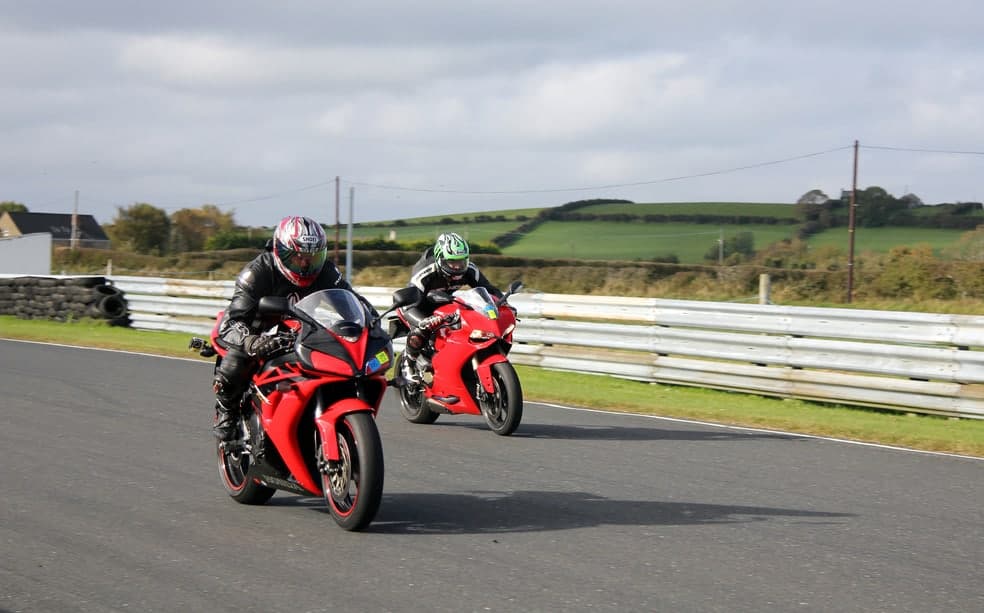Tech Question & Answer

I have a 2005 CBR 1000 RR, which I use for track only use, right now it is in stock form, except for a pipe, pc3, and brake lines. My question to you is in the suspension department, which I think is the most important to concentrate on. I have set the sag front and rear and it seems to be performing pretty good, but I have talked to some people about my front forks and they seem to think that I am bottoming out (hydraulic lock) the zip tie stops at exactly the same spot no matter what I do with the preload so are springs in order? New cartridges? Or what? As for the rear I am not having too many problems but it does feel funny over some bumps, I think it is possibly too soft, my sag (loaded is at 28 mm) should I look at getting a shock? I am running the Shannonville long track at 1 min 57 secs, which in the track days I attend is a pretty good time in hot shoe, I just don’t want to get to the point where I’m over running my suspension and crash! (I’ve yet to hit the pavement!) I run race tires and tire warmers, which so far has been a very good investment, but now I really want to know where to go with my suspension as far as where to put my money first! thanks a lot and can’t wait for your reply!, Broady
Broady, you are right on the money. At Accelerated Technologies we address these exact concerns from all the regional racers. I always try to educate the competitors to the fact that almost all OEM forks have a system in them to protect the fork from bottoming out mechanically, which, if it happens hard enough can damage components or upset the bike enough to cause rider distraction. The system on your bike is the most common, usually referred to as a hydraulic bump stop. On the damping rod inside your fork is a round piston check valve assembly that descends into a ‘bucket’ about 20-25 mm from mechanical bottom, causing your compression damping to go up by about 400-500% basically stopping the fork travel. This is okay when you are straight up and down on the brakes, but can be tragic when trail braking into a corner. This may be why your zip tie keeps ending up at the same spot, you are entering this hydraulic lock and the fork is stopping. The other possibility is that you are actually pushing through this lock and mechanically bottoming, and you just don’t know where bottom is on your fork. Most inverted forks will bottom with about 5 – 15 mm of inner tube still visible, so keep this in mind. The reason it is using so much stroke is due to a number of reasons. First, Honda uses very long top out springs to soften the upper part of the stroke so that the bike still rides with excellent street comfort even though it has very heavy (track capable) main springs. The problem on the race track is that these long top out springs tend to make the bike dive easier when transitioning from full throttle to braking like that experienced on Shannonville’s back straight. This push off from the top of the fork generates extra inertia down that tends to use up more suspension travel. Secondly, your fork’s compression valving is TOO SOFT for the track. Lets face it, if we assume that 90% of sport bikes live out their life on the street and only 10% make it to the track, we can see why the engineers have to build the bike to be safe and comfortable on the street first, knowing that it will be modified if need be for race track duty. When you grab as much brake as you physically can on a 400 lb. motorcycle doing over 250 kph it puts a lot of load on your forks fast! The valving in the stock fork is a bit too light for this load and the bike dives too quickly and too much. The fork oil level also has an effect on how much travel the forks will use up, if the oil level is too low, it provides no assistance in making the fork progressively stiffer near bottom. If the oil level is too high, the fork will never bottom but will feel bouncy and chatter deep in the stroke. The last culprit to excessive suspension travel is having too much rebound. This will prevent the fork from recovering over the little bumps and pack it down, using more travel than it would have if the rebound adjusters were opened to a more appropriate setting. So, for the forks, I would suggest a full supersport preparation that modifies the hydraulic bump stop, stiffens or replaces the compression and rebound pistons and reduces friction throughout the fork. I usually modify the Honda Top out springs and set the spring rate and oil level to your weight. If you want to make it a really nice fork to tune, I usually install aftermarket compression ‘clickers’ to replace the stock compression ‘turners’ on the Showa forks that allow much more precise adjustment and repeat-ability. As for the shock, it may just need to have the compression and rebound set properly, but aftermarket shocks will still provide much better performance and respond better to adjustment. OEM shocks are more difficult to service, and they are made with more economical castings and as such their damping fades when exposed to the high temperatures only seen on the track.
